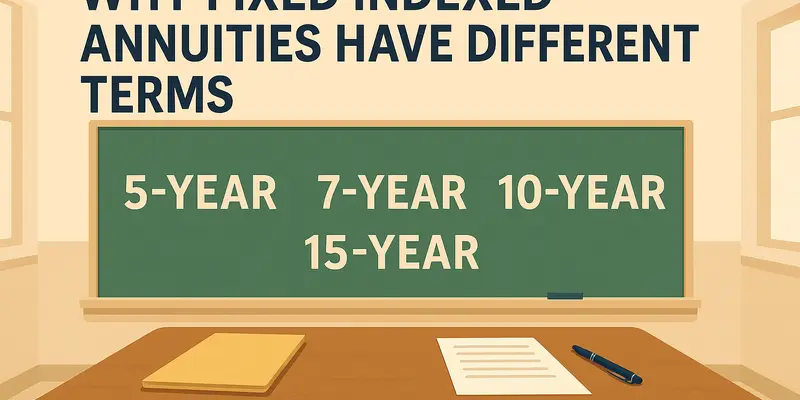You might have noticed that many fixed indexed annuities provide multiple withdrawal-charge terms, such as 5, 7, 10, or even 15 years, for the same product. For example, consider the Athene Agility Fixed Indexed Annuity, which offers both 7- and 10-year withdrawal-charge terms. Insurers do this to let you choose the trade-off that best fits your goals: shorter terms emphasize liquidity and flexibility, while longer terms allow the insurer to invest your premium for longer, which usually supports richer crediting terms such as higher participation rates, caps, or fixed rates.
Why Carriers Offer Multiple Versions
Match different time horizons: A 5- or 7-year term suits someone near retirement who may need access sooner; a 10- or 15-year term fits investors with longer accumulation windows.
Balance return potential and guarantees: Longer commitments give insurers more investment latitude, so they can generally share more upside through better crediting.
Segment features and pricing: Carriers can bundle bonuses, rider availability, or higher fixed rates with longer schedules while keeping shorter versions simpler.
Most Versions are Similar, But Details Matter
Across the same FIA product with different withdrawal-charge terms, roughly 75% of the contract mechanics remain the same regardless of the withdrawal-charge term. You will usually see the same index lineup, the same crediting methods (point-to-point, trigger, fixed), the same core waivers (confinement, disability, terminal illness), a 0% floor, and a Market Value Adjustment that follows the surrender schedule. Documentation, issue states, and general admin rules also tend to be identical.
Where versions meaningfully diverge is in the economics and eligibility. This is where you should slow down and compare the brochure and rate sheets side by side.
What Typically Changes across Withdrawal-charge Versions
Surrender schedule shape and length
Shorter terms: charges end sooner and often start slightly lower.
Longer terms: charges persist for more years and may start a bit higher, then decline annually.
Crediting terms
Longer terms usually offer higher participation rates, higher caps, and sometimes higher fixed rates.
Shorter terms often have more modest rates in exchange for liquidity.
Premium bonuses or enhancements
More common and often larger on longer terms.
Some contracts pair a bonus with slightly lower ongoing crediting rates to balance economics.
Maximum issue age
Shorter terms often permit higher issue ages (for example, up to 85 or 90).
Longer terms may cap issue age lower (often 75 to 80), so the contract can reasonably run to term.
Rider availability
Income riders, enhanced death benefits, and liquidity riders are more frequently offered on longer terms because the longer horizon supports the guarantees.
Shorter terms may limit rider choices or price them less attractively.
Free withdrawal provisions
Most FIAs allow 5% to 10% penalty-free withdrawals each year.
The percentage may be the same across terms, but the impact of surrender charges on amounts above the free window differs because the charge period is longer or shorter.
Market Value Adjustment (MVA)
Most versions include an MVA that can adjust surrender values up or down based on interest rate moves.
The presence and duration of the MVA usually track the surrender schedule.
Renewal-rate posture
Longer terms may receive more supportive renewal rates because the carrier’s asset mix is locked in for longer.
Shorter terms provide flexibility to reallocate sooner if renewal rates become less attractive.
A Simple Side-by-side Illustration
Assume two versions of the same FIA, identical indexing options:
| Feature | 7-Year Version | 10-Year Version |
|---|---|---|
Surrender schedule (yr 1 start) | 9% declining to 0% by year 7 | 10% declining to 0% by year 10 |
S&P 500 1-yr PTP participation | 50% | 60% |
Uncapped Vol Control index participation | 120% | 90% |
Fixed rate | 3.9% | 4.4% |
Premium bonus | None | 10% at issue |
Max issue age | 85 | 80 |
Free withdrawal | 10% | 10% |
Income rider availability | Limited | Available with higher payout factors |
Takeaway: the 10-year version offers stronger crediting and a bonus, but it ties up funds longer and has a lower maximum issue age.
How to Choose the Right Version
Time horizon: If you expect to need the principal within 7 years, shorter terms reduce the chance of paying surrender charges.
Growth priority: If higher accumulation is the priority and you can commit longer, longer terms usually deliver better participation or caps, and may add a bonus.
Age and suitability: Check maximum issue age and any rider age limits.
Liquidity needs: Compare free withdrawal percentages and whether nursing-home, disability, or terminal-illness waivers apply.
Rider goals: If you want guaranteed lifetime income or enhanced death benefits, confirm which versions offer them and at what cost.
Rate sheet reality: Always compare current participation, caps, fixed rates, and renewal-rate practices across versions of the same product.
Quick Checklist Before You Decide
Do I need access within the next 5–7 years?
Will the higher rates or bonus on the longer term materially change my outcome?
What riders matter to me, and which versions allow them?
Does the maximum issue age limit my choice?
How do the free withdrawal, MVA, and health waivers work for each version?
Bottom Line
Different withdrawal-charge versions exist to balance flexibility and earning potential. Shorter schedules favor access and simplicity. Longer schedules reward patience with stronger crediting terms and sometimes bonuses and broader rider menus. The best fit depends on your time horizon, liquidity needs, age, and whether income or legacy features are part of your plan.
We understand that choosing the right annuity can be a complex decision, influenced by a myriad of factors such as market conditions, individual financial goals, and evolving life circumstances. To better serve you in this critical decision-making process, we regularly conduct in-depth reviews of various annuity products, examining features, costs, and potential benefits. Delve deeper into our extensive reviews here.




